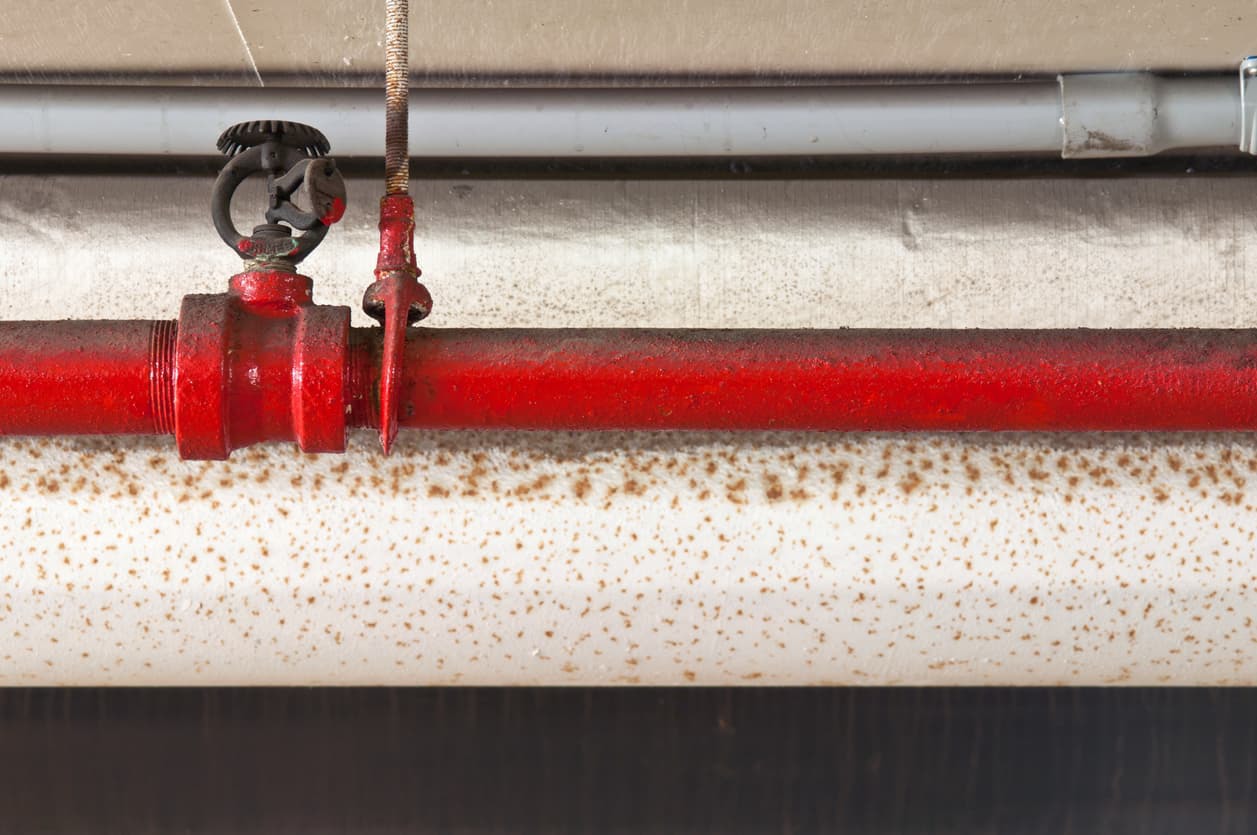How to Mitigate Corrosion in Water-Based Fire Sprinklers
- Regular inspections, testing, and maintenance
- Implement corrosion monitoring services
- Install a corrosion-resistant fire sprinkler with high-quality pipe material
Automatic water-based fire sprinkler systems often act as the first line of defense when a fire breaks out. However, if your fire sprinkler pipes are corroded, they will not perform as designed, putting your occupants, property, and assets in preventable danger.
Before discussing how businesses can mitigate corrosion in their water-based fire sprinklers, builder owners and facility managers need to know the main types of corrosion. Understanding how corrosion occurs and the different types will help businesses prevent this problem from occurring in their fire sprinkler pipes.
The primary cause of corrosion is oxidation. Oxidation is a rust-forming process where trapped oxygen reacts with the metal sprinkler piping. The second main form of corrosion is Microbiologically Influenced Corrosion (MIC). MIC spreads in fire sprinkler systems where bacteria, metal, water, oxygen, and nutrients are present.
Regardless of the type, unchecked fire sprinkler corrosion can lead to serious financial and life safety liabilities, including leaks, facility downtime, occupational hazards, and reoccurring system failure. These issues reduce fire sprinkler functionality and increase maintenance costs.
While eliminating corrosion is difficult to accomplish, there are several steps businesses can take to minimize water-based fire sprinkler deterioration.
3 Ways to Minimize Fire Sprinkler Corrosion
Proactive building owners and facility managers can implement fire sprinkler corrosion control strategies to lengthen the life of their systems. Here are three ways to minimize fire sprinkler corrosion in your facility.
1. Regular Inspections, Testing, and Maintenance
Partnering with a qualified fire protection company to conduct consistent inspections, testing, and preventative maintenance effectively minimizes corrosion for all types of fire sprinkler systems. With routine inspections and licensed professional staff to assist with preventative maintenance, building owners and facility managers can reduce corrosion, clogs, and obstructions, ensuring ongoing reliability.
Fire sprinkler inspections, testing, and preventative maintenance services also help building owners avoid preventable regulatory code violations and adhere to NFPA 25, which requires regular inspections and testing to identify early signs of corrosion.
Related Resource
Learn how often your fire sprinkler should be tested and inspected to ensure functionality and compliance. Learn More →
2. Implement Corrosion Monitoring Services
Fire sprinkler monitoring services are designed to identify early signs of corrosion to prevent expensive repairs, property damage, and system failures. Monitoring solutions for corrosion control helps keep track of metal loss or gas composition in wet or dry fire sprinkler systems, automatically sending notifications to technicians if corrosive activity begins.
Monitoring services also help businesses maintain regulatory compliance. According to NFPA 13, building owners must take corrective action and implement an approved plan for monitoring the interior conditions of the system at established time intervals and locations.
Building owners and facility managers are responsible for notifying the fire sprinkler installer and developing a treatment plan if microbes and the conditions that contribute to microbiologically influenced corrosion (MIC) are present. An experienced fire protection company will install a corrosion-monitoring station to survey a building’s fire sprinkler system at established levels.
3. Install a Corrosion-Resistant Fire Sprinkler with High-Quality Pipe Material
Installing a corrosion-resistant fire sprinkler equipped with high-quality pipe material is another effective way to minimize sprinkler deterioration. Corrosion-resistant fire sprinkler systems are typically plated with corrosion-resistant metal and coated with a protective layer such as wax.
Since some types of piping material are more resistant to corrosion than others, installing higher-quality material such as plastic CPVC, copper, and galvanized steel is essential. It is important to note that galvanized pipes should not be used in environments with a temperature over 130°F (54°C).
Using higher-quality material that is thicker will slow down rust from deteriorating the pipe’s walls. Installing a corrosion-resistant fire sprinkler with high-quality pipe material may be more of an upfront investment. Still, building owners will save significantly over time as their fire sprinkler system will last longer and require less maintenance.
Dig Deeper
Use the Building Owner’s Guide to Fire Sprinkler and Fire Pump Systems to determine which system is right for your building. Learn More →
Extend the Life of Your Fire Sprinkler System with Corrosion Control Services
Addressing corrosion issues will help building owners and facility managers maximize fire sprinkler system integrity, ensure compliance, and enable fast, effective suppression if and when a fire emergency occurs.
Businesses should partner with an experienced fire protection company to implement corrosion control services to extend the life of their fire sprinkler system and reduce the overall cost of maintenance. Corrosion control services are suitable for all types of facilities, including data centers, hospitals, stadiums, warehouses, or any other site where a wet, dry, or pre-action fire sprinkler system exists.








